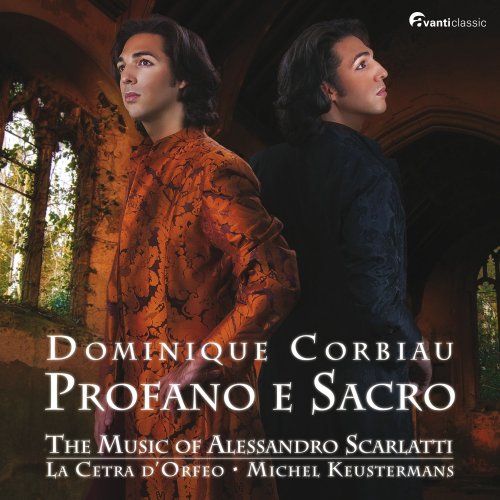Dominique Corbiau & La Cetra D'Orfeo - Profano e Sacro: The Music of Alessandro Scarlatti (2013)

Artist: Dominique Corbiau & La Cetra D'Orfeo
Title: Profano e Sacro: The Music of Alessandro Scarlatti
Year Of Release: 2013
Label: Avanti Classic
Genre: Classical
Quality: FLAC (image + .cue, log, artwork)
Total Time: 1:07:03
Total Size: 374 MB
WebSite: Album Preview
Tracklist:Title: Profano e Sacro: The Music of Alessandro Scarlatti
Year Of Release: 2013
Label: Avanti Classic
Genre: Classical
Quality: FLAC (image + .cue, log, artwork)
Total Time: 1:07:03
Total Size: 374 MB
WebSite: Album Preview
1 Gli Equivoci Nel Sembiante (1679): I. Largo- II. Allegro- III. Balletto 03:16
2 II Ciro (1712) : Aure, Fonti 03:46
L’Amor Volubile E Tiranno (1709)
3 Quanto Grata A Questo Core 04:43
4 I. Presto- II. Andante 01:12
5 III. Allegrissimo 01:27
6 Come di Fronda In Fronda 04:03
7 Il Ciro (1712) Quel Che Piace 02:39
8 Griselda (1721) Colomba Innamorata 04:57
9 II David (1700) I. Grave 01:32
10 II David (1700) II. Allegro 01:38
11 La Giuditta (1697) Dormi O Fulmine di Guerra 05:45
Il Primo Omicidio (1707)
12 Grave 02:22
13 L’olocausto Del Tuo Abelle 03:24
14 I. Andante E Staccato- II. Presto 00:54
15 Or di Strage-Come Mostro 02:17
La Vergine Addolorata (1717)
16 Introduzione : I. Vivace 00:43
17 II. Adagio 01:02
18 III. Allegro 01:44
19 Col Suo Flebil Mormorio 06:32
Venere, Amore e Ragione (1706)
20 I. Presto 01:31
21 II. Andante 00:54
22 III. Allegro 01:31
23 Quella Ninfa 03:02
24 O Pastorelle 03:13
25 Un Vero Amore 02:38
This is the debut recital recording of Belgian countertenor Dominique Corbiau, and it is notable in several respects. First is Corbiau's voice, which is unusually rich and rounded but never plummy, his engagement with the text obvious and sensitive. Most of the arias here are of chamber dimensions, and Corbiau is a natural at this size, but he has power in reserve for when the music ascends into upper registers. Second is the fact that Corbiau avoids well-trodden Baroque repertory on this release. Alessandro Scarlatti is not exactly unknown, but he is generally represented by a few large sacred works, and few of the pieces here are likely to be familiar to general listeners. And third, Corbiau not only represents Scarlatti but explores him intelligently. The program is divided into the "profano e sacro" categories of opera and oratorio, with a second secular category, the serenade, added at the end. All kinds of interesting revelations, many of them non-vocal, emerge as the program unrolls, and Scarlatti's immense influence on the music of the entire 18th century becomes clear. The highly operatic oratorio was largely his creation: the oratorio excerpts here are different in style from the operas, but not greatly different. The big da capo aria that served opera composers for decades afterward largely had its origin in the pieces in the first part of the program. And the many instrumental pieces are likewise interesting: they often are three-section sinfonias that are the ultimate ancestors of the symphony genre. There are lovely instrumental effects, such as those involving the Baroque triple harp of conductor Michel Keustermans and the historical-instrument group La Cetra d'Orfeo employ percussion instruments in some seemingly unscored ways; this isn't discussed in the booklet, so it's hard to know exactly what they were up to. In general, however, this is a model recital, virtuosic in the extreme, yet with vocal beauty placed in service of an unusual repertory. -- James Manheim

![Son Reis Project - Payment Plan (2025) [Hi-Res] Son Reis Project - Payment Plan (2025) [Hi-Res]](https://www.dibpic.com/uploads/posts/2026-01/1767703606_a0226987089_10.jpg)

![Nathanial Young - Live Under The 7 (Live) (2026) [Hi-Res] Nathanial Young - Live Under The 7 (Live) (2026) [Hi-Res]](https://www.dibpic.com/uploads/posts/2026-01/1767514877_cover.jpg)

![McLuhan - Anomaly (2024) [Hi-Res] McLuhan - Anomaly (2024) [Hi-Res]](https://img.israbox.com/img/2026-01/03/17fkljtfa21kq63ydiyulo6tc.jpg)


![Jack Steffen and His Orchestra - Cocktail Club (2026) [Hi-Res] Jack Steffen and His Orchestra - Cocktail Club (2026) [Hi-Res]](https://img.israbox.com/img/2026-01/02/v1reide2thsgtx1fsm6sxz8cq.jpg)